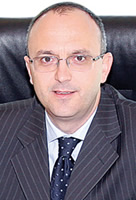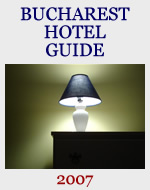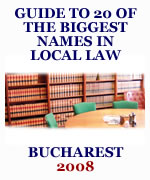No more takeovers due
As Romania welcomes a new banking entity – UniCredit Tiriac Bank – Corina Mica talks to its CEO, Rasvan Radu, about the ups and downs of the local financial market
|
 Central eastern Europe has now passed over the time for banking acquisitions, argues UniCredit Tiriac Bank CEO Rasvan Radu.
Central eastern Europe has now passed over the time for banking acquisitions, argues UniCredit Tiriac Bank CEO Rasvan Radu.
“There are fewer and fewer targets and the costs are higher and higher, so the only viable option for expansion is organic growth,” Radu tells The Diplomat.
Such growth is on the agenda of the new bank, resulting from the mega-merger of Banca Tiriac, HVB Bank and UniCredit Romania in less than two years. The three banks have now created Romania’s fourth largest financial institution in terms of total assets. Dropping the HVB, the body has a new name – UniCredit Tiriac Bank – and will target retail and corporate customers in 37 cities in Romania.
“From the legal point of view this is a merger through absorption, in which HVB Tiriac Bank absorbs UniCredit Romania, for reasons connected to costs and the client database,” says Radu. “A merger is more than just joining up the operations of three banks, it’s a long term process and a complex one. From the procedural point of view, [this month] will be a milestone, to be followed by several other actions, such as mapping out the branch and distribution network and putting together the strategy for the new bank.”
UniCredit Tiriac Bank will have almost 140 branches spread nationwide.
“A process to develop and approve the strategy for the new bank on more levels is now under discussion, and we hope to finalise it by the end of this month and put together a way to grow in Romania,” he says.
Radu argues that each of the three banks come with their own qualities. HVB is a solid bank for large and multinational clients, as well as in real estate and has a focus on Austrian and German clients.
UniCredit has built up relationships with medium-sized companies, both Romanian and Italian, and also brings on board a wide range of Turkish companies. This is because UniCredit had previously taken over the Turkish-based DemirBank in Romania. Meanwhile, Banca Tiriac, which was part of former tennis star and business billionaire Ion Tiriac’s holding firm, has a strong position on the mass-market and connections with small and medium-sized enterprises.
“Taking all these elements, of course there are overlaps, and we need to work to bridge them,” says Radu. “We tackle small companies, with a turnover of under two million Euro, and want to put forward a standard product range and become more active for business customers. Also, in retail, because we have been active in the upper mass-market so far, we also want to address its lower segment.”
With the completion of the merger, combined total assets of 3.7 billion Euro place the new bank in fourth place locally, after Banca Comerciala Romana, BRD - Groupe Societe Generale and Raiffeisen Bank.
“But rankings like this do not stimulate us, we look more at revenue volumes and profitability indexes. Our priority is to maximise such indicators,” says Radu.
Romania’s banking market is competitive and constantly on the rise, and its growth speed is higher than most of the other neighbouring countries.
“There are three countries where UniCredit Group wants to increase its presence, and these are Russia, Turkey and Romania,” says Radu.
Most banks are privately owned in Romania, with state-owned Savings Bank CEC the only notable exception, which makes it a more settled market, argues the CEO.
“But concerning the degree of sophistication of products, Romania is far from [the level seen in] western Europe and EU countries,” says Radu. “Because of the accelerated growth of this market, and because all banks fight for market share, there are many compromises in how risks are taken.”
Such risks, argues the CEO, are connected to thorough screening of customers who take on credits, which is not always carried out in the proper fashion. Thus the quality of the service suffers, but still, there is a positive credit circle in Romania, and there is no short-term non-payment risk, according to Radu.
Another disadvantage of the Romanian banking market is that there is no cohesion at the level of the financial market, he says, adding that Romania’s Banking Association is not a strong enough body and it cannot manage Romania’s market players in a real and cohesive manner.
Also, the central bank (BNR) has recently passed a set of norms loosening up the credit policy of this country. New conditions passed by the BNR include a drastic reduction of the down payment needed when acquiring a product [this is most felt in the mortgage market] and an increase in the indebtedness level one banking client can have: 50 per cent up from only 30 per cent prior to these new norms. Some argue this could lead to over-indebtedness of Romanians and a possible payment default.
Radu feels BNR’s norms are not very clear in terms of the content.
“We, bankers, have found out more details more from direct meetings with those in charge than from the norms,” he says.
“This is somehow understandable, because in Romania it seems that what always counted is the ‘letter’ not the ‘spirit’ of the law. The banking community was expecting a relaxation and, considering this running for volumes in the Romanian banking system, the new rules leave room for more relaxed risk approaches.”
WHO IS RASVAN RADU? |
Formerly vice president with specialism in retail at Austria’s Raiffeisen Bank Romania, Radu says he likes most about his job that fact that this is a competitive environment which rapidly changes and gives him a good perspective on the economic sectors and the main players in the Romanian economy. |
HOW HE GOT HERE |
Rasvan Radu ■ CEO UniCredit Tiriac Bank Education: ■ 2000: Harvard Business School - AMP Previous experience: ■ Since 2005: CEO UniCredit Romania |
BALANCE SHEET: |
UniCredit Tiriac Bank Active in Romania since 1991 (when Banca Tiriac was founded) |








